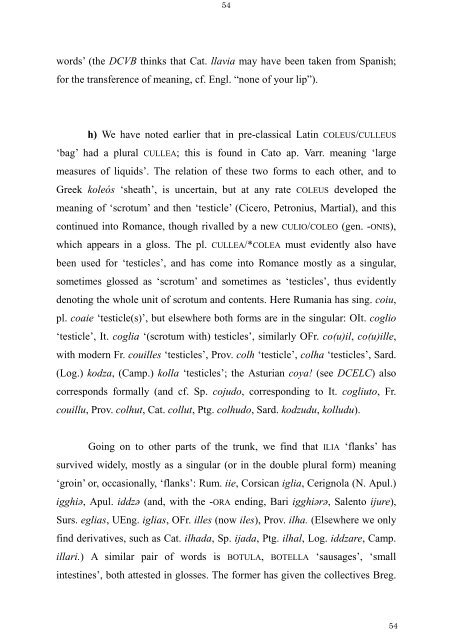The Latin Neuter Plurals in Romance - Page ON
The Latin Neuter Plurals in Romance - Page ON
The Latin Neuter Plurals in Romance - Page ON
You also want an ePaper? Increase the reach of your titles
YUMPU automatically turns print PDFs into web optimized ePapers that Google loves.
54<br />
words’ (the DCVB th<strong>in</strong>ks that Cat. llavia may have been taken from Spanish;<br />
for the transference of mean<strong>in</strong>g, cf. Engl. “none of your lip”).<br />
h) We have noted earlier that <strong>in</strong> pre-classical <strong>Lat<strong>in</strong></strong> COLEUS/CULLEUS<br />
‘bag’ had a plural CULLEA; this is found <strong>in</strong> Cato ap. Varr. mean<strong>in</strong>g ‘large<br />
measures of liquids’. <strong>The</strong> relation of these two forms to each other, and to<br />
Greek koleós ‘sheath’, is uncerta<strong>in</strong>, but at any rate COLEUS developed the<br />
mean<strong>in</strong>g of ‘scrotum’ and then ‘testicle’ (Cicero, Petronius, Martial), and this<br />
cont<strong>in</strong>ued <strong>in</strong>to <strong>Romance</strong>, though rivalled by a new CULIO/COLEO (gen. -<strong>ON</strong>IS),<br />
which appears <strong>in</strong> a gloss. <strong>The</strong> pl. CULLEA/*COLEA must evidently also have<br />
been used for ‘testicles’, and has come <strong>in</strong>to <strong>Romance</strong> mostly as a s<strong>in</strong>gular,<br />
sometimes glossed as ‘scrotum’ and sometimes as ‘testicles’, thus evidently<br />
denot<strong>in</strong>g the whole unit of scrotum and contents. Here Rumania has s<strong>in</strong>g. coiu,<br />
pl. coaie ‘testicle(s)’, but elsewhere both forms are <strong>in</strong> the s<strong>in</strong>gular: OIt. coglio<br />
‘testicle’, It. coglia ‘(scrotum with) testicles’, similarly OFr. co(u)il, co(u)ille,<br />
with modern Fr. couilles ‘testicles’, Prov. colh ‘testicle’, colha ‘testicles’, Sard.<br />
(Log.) kodza, (Camp.) kolla ‘testicles’; the Asturian coya! (see DCELC) also<br />
corresponds formally (and cf. Sp. cojudo, correspond<strong>in</strong>g to It. cogliuto, Fr.<br />
couillu, Prov. colhut, Cat. collut, Ptg. colhudo, Sard. kodzudu, kolludu).<br />
Go<strong>in</strong>g on to other parts of the trunk, we f<strong>in</strong>d that ILIA ‘flanks’ has<br />
survived widely, mostly as a s<strong>in</strong>gular (or <strong>in</strong> the double plural form) mean<strong>in</strong>g<br />
‘gro<strong>in</strong>’ or, occasionally, ‘flanks’: Rum. iie, Corsican iglia, Cerignola (N. Apul.)<br />
igghiə, Apul. iddzə (and, with the -ORA end<strong>in</strong>g, Bari igghiərə, Salento ijure),<br />
Surs. eglias, UEng. iglias, OFr. illes (now iles), Prov. ilha. (Elsewhere we only<br />
f<strong>in</strong>d derivatives, such as Cat. ilhada, Sp. ijada, Ptg. ilhal, Log. iddzare, Camp.<br />
illari.) A similar pair of words is BOTULA, BOTELLA ‘sausages’, ‘small<br />
<strong>in</strong>test<strong>in</strong>es’, both attested <strong>in</strong> glosses. <strong>The</strong> former has given the collectives Breg.<br />
54









